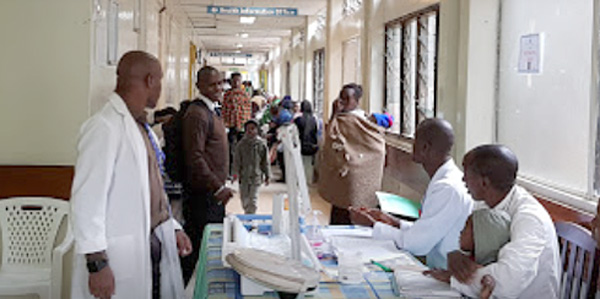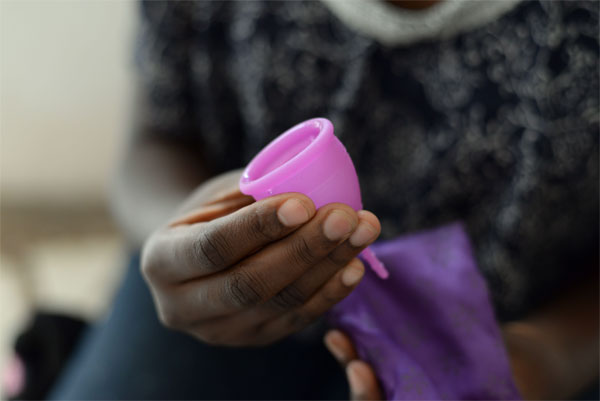Improving quality of life for women with menorrhagia

Heavy menstrual bleeding is a widely overlooked global health issue that may have significant and long-lasting impacts. Lydia Akumu is a practising obstetrician and gynaecologist at Kenyatta National Hospital in Nairobi, Kenya. Dr Akumu was sponsored by JBI’s philanthropy program to participate in the JBI Evidence Implementation Training Program in Adelaide. As part of the JBI Evidence Implementation Program, Dr Akumu undertook a six-month evidence implementation project in her clinical setting under the guidance of JBI research fellows. Dr Akumu’s project aimed to promote evidence-based practice in the assessment and management of patients with heavy menstrual bleeding at Kenyatta National Hospital.
Menorrhagia
Heavy menstrual bleeding (menorrhagia) is defined as excessive or prolonged bleeding during menstruation and can cause considerable disruption to a woman’s life and significantly affect quality of life. It is a risk factor for iron-deficiency anaemia and it is the most common singular cause of iron-deficiency anaemia in women in the reproductive age group. Heavy menstrual bleeding is prevalent. A study conducted across Southern Asia and Sub-Saharan Africa found prevalence to be 38·3% to 77·6%, with a pooled average of 48·6%.
Heavy menstrual bleeding can result from various underlying causes, including hormonal imbalances, structural abnormalities such as uterine fibroids, bleeding disorders, and endocrine issues such as thyroid dysfunction or polycystic ovary syndrome. Among these, bleeding disorders are frequently under-diagnosed, despite the availability of cost-effective laboratory tests.

"I work in a resource-limited setting where I get to see women with heavy menstrual bleeding, most of whom suffer in silence due to cultural limitations and financial constraints. My biggest drive is to provide the best care for these women at the lowest possible cost so as to alleviate their suffering. And this is best achieved through the practice of evidence-based medicine".

Background
Kenyatta National Hospital is the largest referral hospital in East Africa. The gynaecology outpatient clinic at the hospital has a daily patient flow of approximately 40 patients. Heavy menstrual bleeding is the most common complaint among women referred to the clinic.
"I wanted to implement better management of heavy menstrual bleeding that invariably leads to iron-deficiency anaemia and untold psychological and emotional suffering in many Kenyan women. With correct diagnosis, management of heavy menstrual bleeding is rather simple, but this is rarely done in many Kenyan settings. We tend to focus more on the issues that affect pregnant women and somehow we ignore the issues that affect non-pregnant women, which are mostly heavy menstrual bleeding or other issues around menstruation. Most of them suffer in silence."
Dr Akumu says that despite heavy menstrual bleeding being a significant public health problem common in women aged between 30 and 49 years, there is a lack of data on menorrhagia in Kenya: "This includes prevalence data, aetiology and outcomes after management of patients with heavy menstrual bleeding."
"We had no protocol for the evaluation and management of patients with menorrhagia."

From evidence to impact
Dr Akumu’s evidence implementation project commenced with a clinical audit to determine the knowledge needs of healthcare professionals in performing evidence-based assessment and management of heavy menstrual bleeding. Following the audit, a series of education sessions for health practitioners was conducted. The sessions aimed to promote the use of the best available evidence to improve the assessment and management of patients with heavy menstrual bleeding, and included training on hysteroscopy and the insertion of levonorgestrel intra-uterine systems (LNG-IUS).
In addition, clear guiding protocols were created based on the National Institute for Health and Care Excellence (NICE) guidelines for heavy menstrual bleeding: assessment and management, and were made readily available in consultation rooms.
Patients were also educated about heavy menstrual bleeding and their management options, for example, patients were directed on where to obtain LNG-IUS. Empowering women with heavy menstrual bleeding by equipping them with knowledge about their condition and the possible management options for them, was an important part of the project for Dr Akumu.

"The major impact we have had, in my opinion, is the education of these women in helping them accept that this is a condition like any other, and the management options that are there could actually improve their quality of life."
A follow-up audit to assess the outcomes of the interventions demonstrated a number of improvements; for example, compliance increased from 85% to 100% for thorough assessment, including a medical history and physical examination, of patients presenting with heavy menstrual bleeding to determine the cause and to guide the need for further investigation and choice of management.
Compliance in the following areas also reached 100%:
- complete blood count tests being performed for patients presenting with heavy menstrual bleeding to determine the presence of anaemia;
- information being provided to patients about heavy menstrual bleeding and its management, and health practitioners engaging patients in discussion to allow patients to contribute to the decision regarding the most appropriate treatment;
- patients with heavy menstrual bleeding with no identified pathology and fibroids less than 3cm in diameter or with suspected or diagnosed adenomyosis being managed with a LNG-IUS or medications, for example, tranexamic acid, NSAIDs, combined hormonal contraception or cyclical oral progesterone if LNG-IUS is not appropriate or if the patient refuses LNG-IUS.
The lack of outpatient department hysteroscopy services, which was identified in the baseline clinical audit, was also addressed. In fact, identifying and utilising the available resources were major successes of the project: "We already had the resources, but we didn’t know how to implement the evidence". Indeed, the referral of patients with heavy menstrual bleeding with submucosal fibroids for hysteroscopic removal increased from 33% to 90% during the six-month evidence implementation project.
Sustainability and scalability
Throughout the project, engagement levels were high. Dr Akumu says that both clinicians and patients were eager to learn more about the condition. The challenge in implementing the project was more around a lack of financial resources.
"We had limited finances to implement all the strategies, such as offering outpatient hysteroscopy services. If I were to redo the project, I would involve the Ministry of Health for funding as they were very willing to take part after learning the outcomes of the implementation project."
Dr Akumu believes that the project can be transitioned to scale and incorporated into national guidelines to achieve standardised management of heavy menstrual bleeding across the country. Already, the project’s success at Kenyatta National Hospital has been replicated in several other hospitals in Kenya.
"The project led to the development and adaptation of protocols for the assessment and management of women with heavy menstrual bleeding in the largest referral hospital in Kenya. These have since been adopted by several other hospitals including Kapsabet County Referral hospital, where I am currently stationed."
This project was also recognised by the Ministry of Health and won a first runner-up award for the most innovative student project in the Quality Healthcare Awards in Kenya. It was lauded by the Kenyan Health Minister for improving the quality of lives of women in Kenya.
Dr Akumu published an implementation report in JBI Evidence Implementation, which provides more detailed information on how knowledge levels were improved for both caregivers and patients on current evidence-based practices for heavy menstrual bleeding, and how protocols were formulated and adopted at Kenyatta National Hospital, which led to the standardisation of care for women with heavy menstrual bleeding.
Key take home messages
- Through clinical audits, staff education, and development of clear guiding protocols based on evidence, the project bridged the gap between research and practice, resulting in 100% compliance in key areas such as thorough patient assessment, anaemia screening, and informed patient participation in treatment decisions.
- The impact extended beyond a single hospital, with protocols adopted by other facilities in Kenya, demonstrating how the implementation of evidence guided by JBI’s evidence implementation framework can drive sustainable, system-wide change in women’s healthcare.
- The project leveraged existing but underused resources, demonstrating that significant improvements don’t always require new funding. The resources were not used routinely due to a lack of clinical protocols, provider training, and awareness of how and when to use them effectively.
References
Hapangama, D. K., & Bulmer, J. N. (2016). Pathophysiology of heavy menstrual bleeding. Women's Health, 12(1), 3–13. https://doi.org/10.2217/whe.15.81
Karlsson, T. S., Marions, L. B., & Edlund, M. G. (2014). Heavy menstrual bleeding significantly affects quality of life. Acta Obstetricia et Gynecologica Scandinavica, 93(1), 52–57.
Munro, M. G., Mast, A. E., Powers, J. M., Kouides, P. A., O’Brien, S. H., Richards, T., Lavin, M., & Levy, B. S. (2023). The relationship between heavy menstrual bleeding, iron deficiency, and iron deficiency anemia. American Journal of Obstetrics & Gynecology, 229(1), 1–9.
National Institute for Health and Care Excellence. (2018). Heavy menstrual bleeding: Assessment and management (NICE Guideline NG88). NICE.
Sinharoy, S. S., Chery, L., Patrick, M., Conrad, A., Ramaswamy, A., Stephen, A., Chipungu, J., Reddy, Y. M., Doma, R., Pasricha, S.-R., Ahmed, T., Chiwala, C. B., Chakraborti, N., & Caruso, B. A. (2023). Prevalence of heavy menstrual bleeding and associations with physical health and wellbeing in low-income and middle-income countries: A multinational cross-sectional study. The Lancet Global Health, 11(11), e1775–e1784.
Additional resources
Akumu, L. A., Ratemo, S. N., & Owende, P. (2021). Assessment and management of women with heavy menstrual bleeding in Kenya: a best practice implementation project. JBI Evidence Implementation, 19(2), 190–197.
JBI Manual for Evidence Implementation
Getting Research into Practice (GRiP method)